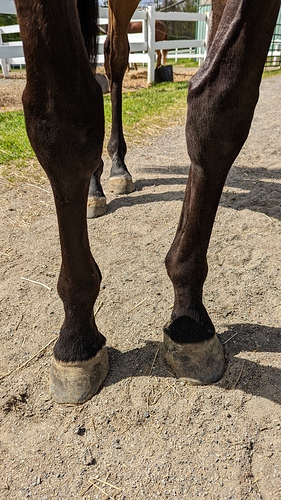My OTTB-with-good-feet luck has run out—I got one in about two weeks ago who came barefoot behind (but a little short) and with a terrible hack shoe job up front. At first glance, he was a bit footsore behind and “tracky,” but nothing out of the ordinary.
I planned to keep the front shoes on, but with such minimal foot to hang onto, that lasted about two days until he sprung a shoe. Farrier was nearby and pulled both front shoes but was horrified by the feet, and upon pulling one of them, several nail holes started bleeding. Cool. He guessed that about four of the nails were hot, was mortified that any farrier would’ve attempted tacking a shoe on that foot, to begin with, and was astounded that the horse was even remotely sound. (This horse is already incredibly special to me given his soundness and attitude through this incredibly painful ordeal.  ) Luckily, the bleeding stopped quickly, and we didn’t see the immediate need to do an X-ray. That was nine days ago. We packed his feet for a couple of days and started a daily Keratex routine.
) Luckily, the bleeding stopped quickly, and we didn’t see the immediate need to do an X-ray. That was nine days ago. We packed his feet for a couple of days and started a daily Keratex routine.
Since then, he’s improved tremendously. The quality of the foot isn’t terrible—it’s solid, not shelly, but there isn’t much of it, and the sole is relatively thin—and he is sound at the walk on “normal” surfaces like our paddocks, our ring, the barn aisle, etc. I know there can be quite a transition period for horses growing foot and adjusting to barefoot life, so I’m wondering if it’s appropriate to bring him into light work, like very, very basic transitions on the lunge line, groundwork, and rudimentary under saddle skills (mounting block manners and so on) that I do with all my OTTBs. I don’t want to hinder any progress, but it seems to me like circulation and blood flow to his feet will be a positive thing within reason?
Here’s a (poor) video of him walking under tack on Sunday: https://photos.app.goo.gl/jP4JwiSAvZisnstc8 (He was VERY offended that we came to a grass field to work and not eat grass.  Is he not the most handsome bugger you’ve ever seen?) As I said, plenty accustomed to OTTB acclimatization, but have never dealt with feet quite this bad. TIA!
Is he not the most handsome bugger you’ve ever seen?) As I said, plenty accustomed to OTTB acclimatization, but have never dealt with feet quite this bad. TIA!



